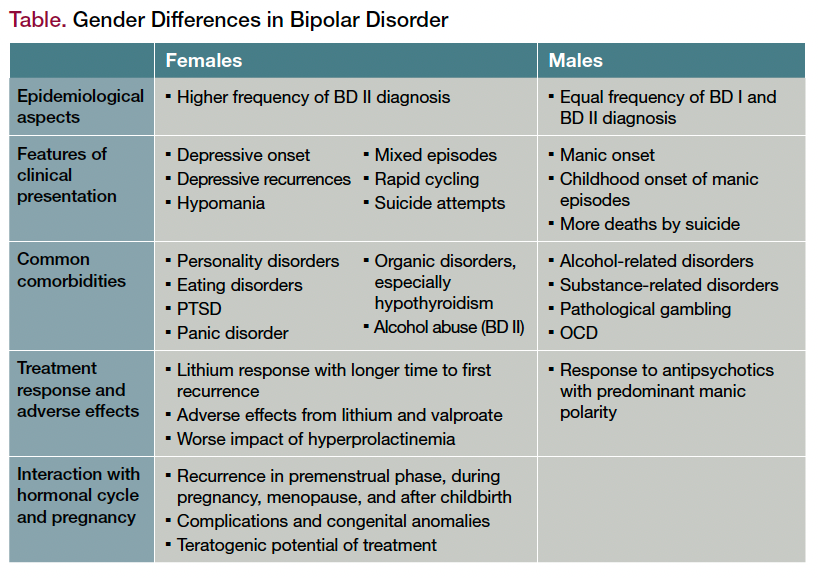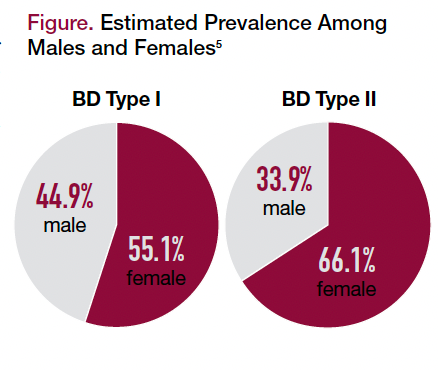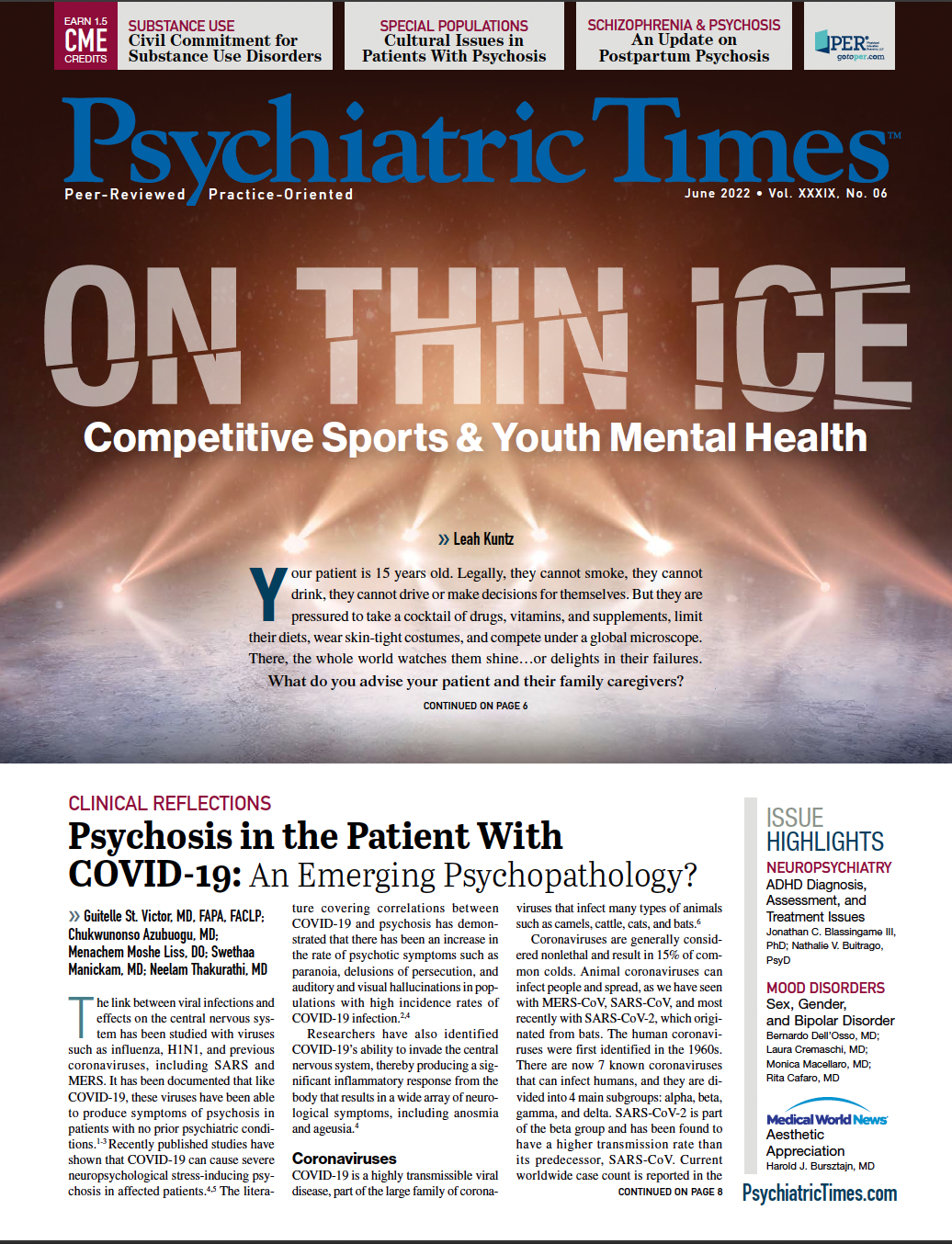Publication
Article
Psychiatric Times
Gender and Sex Issues in Bipolar Disorder
Author(s):
What are the differences in epidemiological and clinical characteristics of bipolar disorder between the sexes?
tostphoto_AdobeStock

Bipolar disorder (BD) affects 1% to 3% of the world’s population and is characterized by alterations in mood, levels of energy, and functioning. Despite these common features, BD includes a group of polymorphic and heterogeneous conditions in terms of clinical presentation, course, response to treatment, and functional outcome.1 Several sociodemographic and clinical variables have been investigated as potential factors influencing the development and course of illness, such as age at onset, employment status, marital status, number of manic/depressive episodes, predominant polarity, and—above all—gender and sex.2
There has been a rising interest in gender-related specificities in BD (Table).
Table. Gender Differences in Bipolar Disorder

However, the presence of clinical and epidemiological distinctions between male and female patients and their role in the diagnostic and therapeutic process is still controversial.3 Sex specificity may affect many variables, including incidence, prevalence, subtypes (BD I and BD II), rapid cycling, suicidal behavior, comorbidities, treatment response, and adverse effects. Moreover, among females, hormonal oscillations related to the menstrual and reproductive cycle may influence the disease and its treatment.4
Epidemiological and Clinical Aspects
Compelling evidence has documented an almost equal male-female sex ratio in incidence and lifetime BD prevalence rates (Figure).5
Figure. Estimated Prevalence Among Males and Females5

Nonetheless, recent studies suggest an increased frequency of BD diagnosis among women, for both BD I and BD II. Furthermore, hypomania, and consequently BD II subtype, are more frequently associated with female sex.5
Although age at first mood episode does not apparently differ between women and men, men more commonly experience a first manic episode during childhood.6 Men more often have a first manic episode, whereas women seem more likely to face a depressive one.5 In addition, being female is more frequently related to depressive recurrences, depressive predominant polarity, and higher lifetime prevalence of psychotic depression.7,8
Women more often report depression and large fluctuations in mood as well as more frequent mood oscillations across the menstrual cycle.9 On this basis, the identification of BD in women may be more challenging, leading to a higher rate of misdiagnosis of major depressive disorder. Indeed, some other characteristics may help clinicians in the successful recognition of BD in women, including lifetime rapid cycling10,11 and mixed hypomania.12,13 The probability of mixed symptoms in females increases consistently with the severity of hypomania but decreases at the most severe levels of hypomania.14
Suicide attempt rates have been significantly more frequent among females, even though death by suicide has occurred more commonly in men.2 As a result, physicians should consider the possibility of an unrecognized bipolar diathesis if they see frequent depressive recurrences despite antidepressant therapy, the presence of psychotic features during a depressive episode, and a high number of suicide attempts in women.
Psychiatric and medical comorbidities often negatively affect BD course, regardless of sex. Comorbidity with alcohol and other substance use disorders (eg, cannabis abuse/dependence and pathological gambling) has been more frequently documented among males.8,15,16 However, Goodwin and Jamison have suggested a higher prevalence of alcohol abuse among women with BD II.17 Co-occurrence of personality disorders (particularly of cluster B), eating disorders such as bulimia, and posttraumatic stress disorder was generally observed with a higher frequency among females.16,18 A sex-specific effect has also been illustrated for comorbid obsessive-compulsive disorder (OCD) and anxiety spectrum disorders, with increased OCD rates in males and panic disorder in females. Organic conditions such as migraine, thyroid disorders (especially hypothyroidism), and autoimmune disorders seem to be more commonly associated with female gender in BD.19
Previous investigation of sex differences in the most affected domains in BD—including executive function, verbal and visual memory, verbal learning, attention and processing speed—did not identify differing results. However, recent findings showed a better performance in working memory tasks among males, whereas a better performance was found in verbal learning and memory recognition tasks among females.20 Finally, a sex differential emerged in psychosocial functioning, with females with BD tending to report better social and occupational status than their male counterparts.21
Treatment Differences
The correlation between sex/gender and response to pharmacological treatment has been extensively investigated, with a particular focus on mood stabilizers and antipsychotics. Beyond an increased use of antidepressants, women with BD seem to more frequently receive a combination treatment, whereas men have more often reported receiving lithium.22 Considering sex differences in clinical response to lithium, a pooled data analysis outlined response rates of 65.6% in women and 61.0% in men. Another longitudinal study found that, in comparison with men treated with lithium, women treated with lithium had a significantly longer median time to first recurrence.23,24
The use of antipsychotics in BD has increased in past decades, apparently with no differences in their prescription.22 Regarding efficacy, in an 8-week trial of treatment with placebo, olanzapine, or olanzapine/fluoxetine in combination, male patients with depression and manic-predominant polarity experienced higher rates of improvement compared with those with depressive polarity. Among females, no differences in terms of response were observed by means of predominant polarity.25
Some authors have hypothesized a correlation between sex and occurrence, intensity, and type of medication adverse effects, thus influencing their prescribing patterns. Regarding lithium, female sex emerged as the main risk factor for the development of hypothyroidism during treatment, especially for women aged 40 to 59 years. Valproate use in females may lead to polycystic ovaries, polycystic ovary syndrome, hyperandrogenism, and obesity. Valproate needs to have an extremely low priority in women of childbearing potential due to the important risks of neurodevelopmental delays and polycystic ovary. However, it can be effective and well tolerated in females not of reproductive potential. Moreover, many typical and some atypical antipsychotics may be associated with hyperprolactinemia, which can result in galactorrhea, amenorrhea, and other menstrual cycle irregularities.3 Although females with BD were generally more adherent to therapeutic indications, they nonetheless seemed to be more concerned about adverse effects like weight gain.26
In terms of nonpharmacological strategies, female patients with depression underwent significantly fewer antidepressant drug trials than their male counterparts before being prescribed electroconvulsive therapy. When used in patients with schizophrenia, its effectiveness was greater in females, but this difference was not replicated in individuals with BD, possibly because of the small sample size.23,27 No evidence supported the notion of a different response to psychotherapy between genders.23
Female Reproductive Cycle
Women physiologically experience endogenous fluctuations in ovarian hormone levels, including recurring oscillation of estradiol and progesterone. These fluctuations may affect BD pathophysiology and clinical presentation. It is worth noting that symptoms may worsen when gonadal hormone levels are low, either during the premenstrual phase of the cycle—thus hindering the distinction from premenstrual dysphoric disorder4—and postpartum.28 This period may be burdened by a relevant risk of BD onset and relapse. For instance, a recent meta-analysis found an overall postpartum relapse risk of 37%, with almost a quarter of those suffering from affective psychosis, mania, mixed episodes, or relapses requiring hospitalization, and the remaining patients suffering from nonpsychotic affective episodes, mostly depressive.28 Accordingly, clinical trials suggested that exogenous estrogenic treatments may improve specific symptoms of BD.4
During pregnancy, women with BD should undergo close monitoring because of the correlation between BD and pregnancy complications, as well as potential congenital anomalies in infants. The discontinuation of medications may trigger a mood recurrence and thus lead to disruption of daily living functioning, including a patient’s ability to take care of the child.28 By contrast, the teratogenic potential of various mood stabilizers must be kept in mind; lithium may enhance the risk of cardiovascular malformations (such as Ebstein anomaly), and valproate and carbamazepine are both associated with the risk of neural tube defects, including spina bifida. Hence, when treating women with BD who wish to become pregnant, the risk-benefit ratio should be assessed by evaluating the teratogenic risk of pharmacotherapy and the negative impact of untreated BD symptoms on the pregnant woman and the fetus.3
The same shrewdness should be promoted in treating women with BD during breastfeeding. Some mood stabilizers, including carbamazepine and valproate, are not contraindicated, whereas lithium is not compatible with lactation. In addition, there is no consensus regarding the use of antipsychotics during pregnancy and breastfeeding.29
Finally, during the menopause transition, many women face unspecific mood symptoms. In females with BD, the perimenopausal phase may enhance mood instability, with increased depressive symptoms and reduced manic symptoms.30
Concluding Thoughts
Some epidemiological and clinical characteristics of BD may differ between the sexes. Although further investigation is encouraged, the preceding preliminary findings may guide practitioners in clinical practice by facilitating BD identification, especially in case of depressive onset, and by orienting treatment interventions, with a special focus on life events related to the female reproductive cycle. The effort should go towards avoiding valproate and carbamazepine in women of child-bearing potential, unless associated with hormonal contraceptives.
Dr Dell’Osso is an associate professor of psychiatry at the University of Milan, and director of the psychiatric clinic of the Ospedale Luigi Sacco-Polo Universitario of Milan. He is also a scientific advisor in the Department of Psychiatry and Behavioral Sciences of Stanford University and cochair of the International College of Obsessive Compulsive Spectrum Disorders. Dr Cremaschi is a psychiatrist in the Department of Psychiatry, University of Milan. Dr Macellaro is a resident in psychiatry in the Department of Biomedical and Clinical Sciences of the University of Milan. Dr Cafaro is a resident in psychiatry in the Department of Biomedical and Clinical Sciences of the University of Milan.
In the last 3 years, Dr Dell’Osso has received lecture honoraria and research grants from Angelini, Lundbeck, Janssen, Pfizer, Otzuka, Neuraxpharm, and Livanova. The other authors have no conflicts to declare.
References
1. Vieta E, Berk M, Schulze TG, et al. Bipolar disorders. Nat Rev Dis Primers. 2018;4:18008.
2. Diflorio A, Jones I. Is sex important? gender differences in bipolar disorder. Int Rev Psychiatry. 2010;22(5):437-452.
3. Arnold LM. Gender differences in bipolar disorder. Psychiatr Clin North Am. 2003;26(3):595-620.
4. Gogos A, Ney LJ, Seymour N, et al. Sex differences in schizophrenia, bipolar disorder, and post-traumatic stress disorder: are gonadal hormones the link? Br J Pharmacol. 2019;176(21):4119-4135.
5. Dell’Osso B, Cafaro R, Ketter TA. Has bipolar disorder become a predominantly female gender related condition? analysis of recently published large sample studies. Int J Bipolar Disord. 2021;9(1):3.
6. Kennedy N, Boydell J, Kalidindi S, et al. Gender differences in incidence and age at onset of mania and bipolar disorder over a 35-year period in Camberwell, England. Am J Psychiatry. 2005;162(2):257-262.
7. Altshuler LL, Kupka RW, Hellemann G, et al. Gender and depressive symptoms in 711 patients with bipolar disorder evaluated prospectively in the Stanley Foundation Bipolar Treatment Outcome Network. Am J Psychiatry. 2010;167(6):708-715.
8. Nivoli AMA, Pacchiarotti I, Rosa AR, et al. Gender differences in a cohort study of 604 bipolar patients: the role of predominant polarity. J Affect Disord. 2011;133(3):443-449.
9. Buoli M, Cesana BM, Dell’osso B, et al. Gender-related differences in patients with bipolar disorder: a nationwide study. CNS Spectr. 2019;24(6):589-596.
10. Rasgon N, Bauer M, Grof P, et al. Sex-specific self-reported mood changes by patients with bipolar disorder. J Psychiatr Res. 2005;39(1):77-83.
11. Schneck CD, Miklowitz DJ, Miyahara S, et al. The prospective course of rapid-cycling bipolar disorder: findings from the STEP-BD. Am J Psychiatry. 2008;165(3):370-377.
12. Buoli M, Cesana BM, Maina G, et al; ISBD Italian Chapter Epidemiologic Group. Correlates of current rapid-cycling bipolar disorder: results from the Italian multicentric RENDiBi study. Eur Psychiatry. 2019;62:82-89.
13. Arnold LM, McElroy SL, Keck PE Jr. The role of gender in mixed mania. Compr Psychiatry. 2000;41(2):83-87.
14. Kessing LV. Gender differences in the phenomenology of bipolar disorder. Bipolar Disord. 2004;6(5):421-425.
15. Suppes T, Mintz J, McElroy SL, et al. Mixed hypomania in 908 patients with bipolar disorder evaluated prospectively in the Stanley Foundation Bipolar Treatment Network: a sex-specific phenomenon. Arch Gen Psychiatry. 2005;62(10):1089-1096.
16. Kawa I, Carter JD, Joyce PR, et al. Gender differences in bipolar disorder: age of onset, course, comorbidity, and symptom presentation. Bipolar Disord. 2005;7(2):119-125.
17. Goodwin FK, Jamison KR. Manic-Depressive Illness: Bipolar Disorders and Recurrent Depression, Second Edition. Oxford University Press; 2007.
18. Baldassano CF, Marangell LB, Gyulai L, et al. Gender differences in bipolar disorder: retrospective data from the first 500 STEP-BD participants. Bipolar Disord. 2005;7(5):465-470.
19. Suominen K, Mantere O, Valtonen H, et al. Gender differences in bipolar disorder type I and II. Acta Psychiatr Scand. 2009;120(6):464-473.
20. Saunders EFH, Fitzgerald KD, Zhang P, McInnis MG. Clinical features of bipolar disorder comorbid with anxiety disorders differ between men and women. Depress Anxiety. 2012;29(8):739-746.
21. Solé B, Varo C, Torrent C, et al. Sex differences in neurocognitive and psychosocial functioning in bipolar disorder. J Affect Disord. 2022;296:208-215.
22. Sanchez-Autet M, Arranz B, Safont G, et al. Gender differences in C-reactive protein and homocysteine modulation of cognitive performance and real-world functioning in bipolar disorder. J Affect Disord. 2018;229:95-104.
23. Karanti A, Bobeck C, Osterman M, et al. Gender differences in the treatment of patients with bipolar disorder: a study of 7354 patients. J Affect Disord. 2015;174:303-309.
24. Viguera AC, Tondo L, Baldessarini RJ. Sex differences in response to lithium treatment. Am J Psychiatry. 2000;157(9):1509-1511.
25. Viguera AC, Baldessarini RJ, Tondo L. Response to lithium maintenance treatment in bipolar disorders: comparison of women and men. Bipolar Disord. 2001;3(5):245-252.
26. Vieta E, Berk M, Wang W, et al. Predominant previous polarity as an outcome predictor in a controlled treatment trial for depression in bipolar I disorder patients. J Affect Disord. 2009;119(1-3):22-27.
27. Bloch Y, Ratzoni G, Sobol D, et al. Gender differences in electroconvulsive therapy: a retrospective chart review. J Affect Disord. 2005;84(1):99-102.
28. Vega P, Barbeito S, Ruiz de Azúa S, et al. Bipolar disorder differences between genders: special considerations for women. Womens Health (Lond). 2011;7(6):663-674; quiz 675-676.
29. Wesseloo R, Kamperman AM, Munk-Olsen T, et al. Risk of postpartum relapse in bipolar disorder and postpartum psychosis: a systematic review and meta-analysis. Am J Psychiatry. 2016;173(2):117-127.
30. Sharma V, Burt VK, Ritchie HL. Bipolar II postpartum depression: detection, diagnosis, and treatment. Am J Psychiatry. 2009;166(11):1217-1221. ❒







